Ever wondered how to bring out the best in your Douglas fir woodwork? Did you know staining it can significantly enhance its beauty? Let’s embark on this DIY journey together!

Douglas fir is a popular wood type that uses for making boats, aircraft, and many other small and large constructions.
You are watching: Staining Douglas Fir in 7 EASY Steps + Best Stain Colors
Therefore, Douglas fir is used for many woodworking projects, and they last longer with proper finishing.
When I was finishing my Douglas fir woodworking projects, I was curious about staining them.
So, I did deep research to find out the staining capabilities of Douglas fir with the help of some of my woodworkers.
Now with years of experience, here’s what I know about, Staining Douglas fir,
To stain Douglas Fir, first sand the wood with medium-grit sandpaper. Clean off dust, then apply a wood conditioner to help ensure even staining. After it dries, apply your chosen stain with a brush or rag, following the grain. Let it sit, then wipe off excess before it dries.
But that’s a quick snapshot and there’s a lot more to know.
So, in this article we’ll deeply discuss, does Douglas fir stain well, what is the best stain for Douglas fir, and how to stain Douglas fir properly.
Furthermore, we’ll answer some frequently asked questions as well.
So, let’s keep going!

Can You Stain Douglas Fir?
Yes, you absolutely can stain Douglas Fir, and the result can be breathtakingly beautiful if done correctly.
Douglas Fir, a softwood, has a naturally warm color, featuring hues of orange-red to reddish-brown.
This distinctive appearance can be further enhanced by staining. Staining not only augments the wood’s aesthetic appeal but also offers protection against environmental factors.
Let’s delve deeper into the process, common issues, and solutions in staining Douglas Fir.
Understanding Douglas Fir Wood Characteristics
Before we jump into the staining process, it’s important to understand the characteristics of Douglas Fir.
It’s a softwood, which means it has large, uneven pores. While this leads to the wood being lightweight and easy to work with, it also means that the stain can sometimes penetrate unevenly.
This can lead to blotches or splotches in the finished product. However, using the correct staining process and products can minimize this issue.
Keep in mind that achieving the perfect stain might require some trial and error. Always test your chosen stain on a scrap piece of Douglas Fir before going all-in on your project.
This way, you can adjust the stain color and application technique to achieve your desired result.
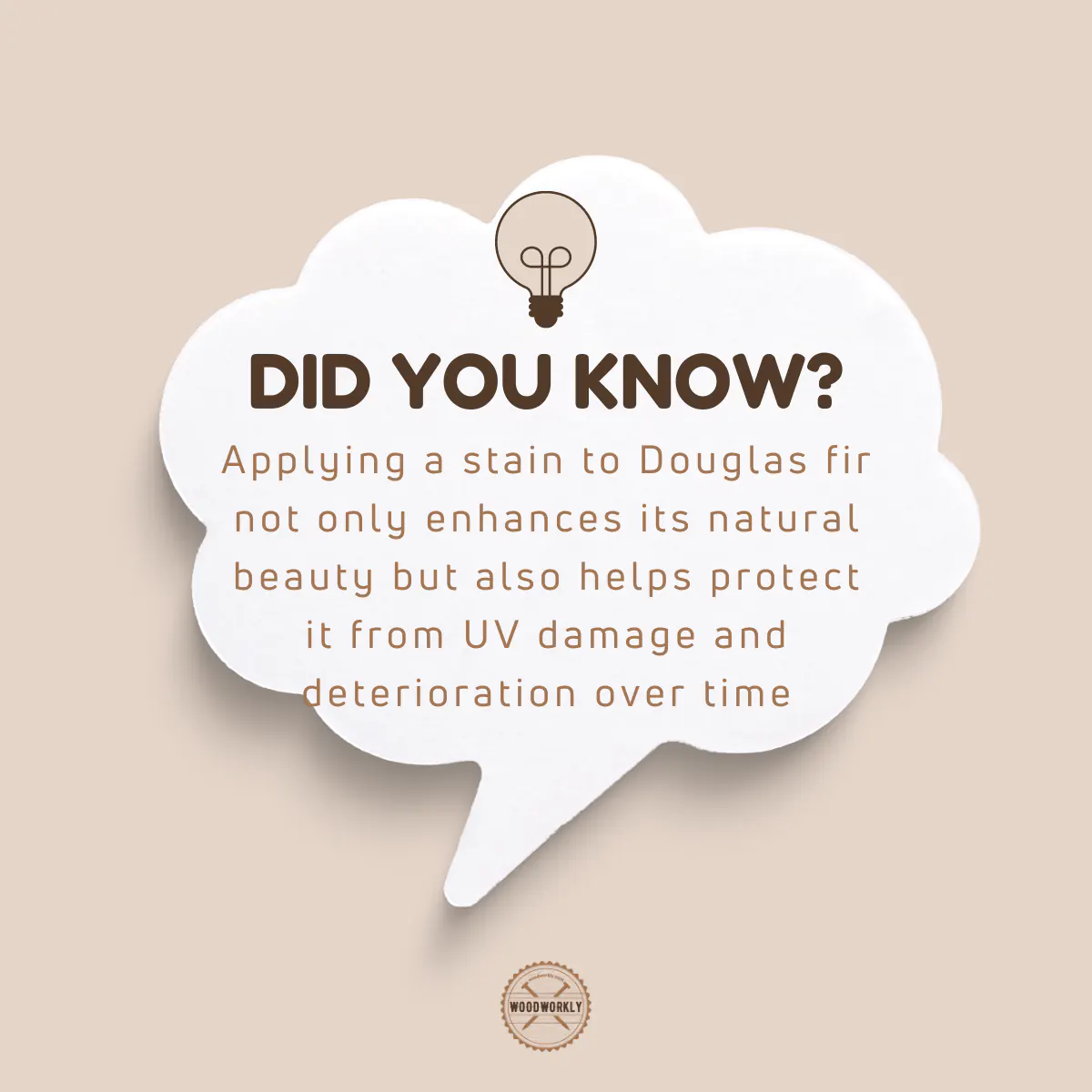
Is Douglas Fir Good for Staining?
Yes, Douglas Fir is good for staining, but you need to have a lot of preparation and patience.
The variable porosity and uneven texture of Douglas fir make the wood so hard to stain.
Staining Douglas fir to get its natural shade is a challenging task.
The vertical grain pattern differs according to the porosity of different areas of the wood and hard to achieve the color as we wish.
Careful preparation and patience are the keys to success in Douglas fir staining.
The bright red and orange color hues of Douglas fir can pop through the stain. Therefore, it’s important to know what the best stain products for Douglas fir staining are.
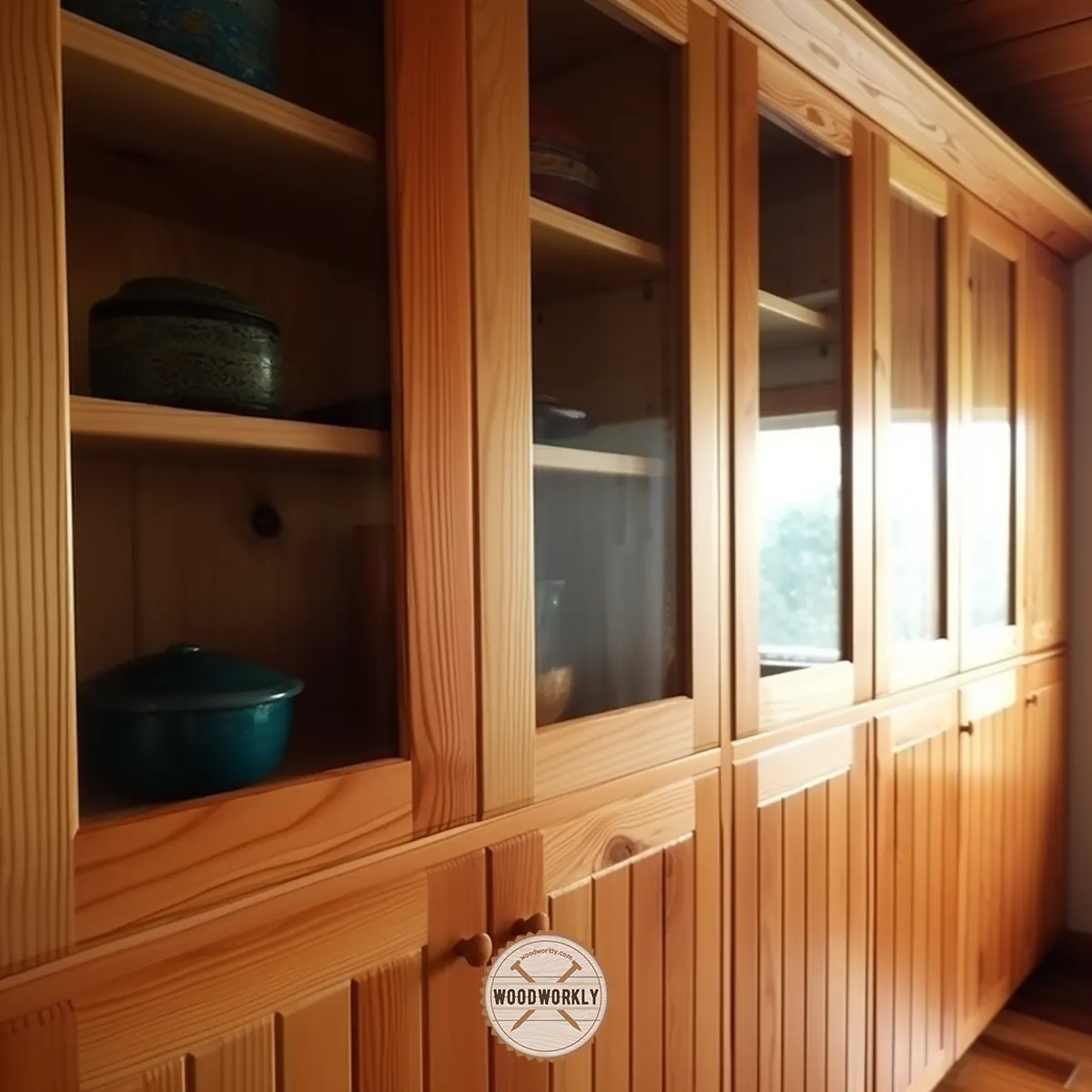
What Is the Best Stain for Douglas Fir?
Even though mostly any stain works well with Douglas fir, Gel stain is considered the best stain product for Douglas fir.
When it comes to staining Douglas Fir, there are a handful of stains that stand out as particularly well-suited to this unique wood.
Your ideal choice will depend on the specific look you’re after, the wood’s location and condition, and your personal preferences.
Let’s delve into the world of stains and find out which ones are considered the best for Douglas Fir.
Gel Stains: A Top Pick
Many woodworking experts vouch for the use of gel stains on Douglas Fir.
Gel stains, such as Minwax’s Gel Stain, are often hailed as the best stain choice due to their thick consistency.
Unlike liquid stains, they form a film on the wood surface rather than penetrating deeply into the pores.
This characteristic of gel stains gives you more control during application, reduces blotching, and results in a more uniform color.
Another advantage of gel stains is their slower drying time.
This gives you the opportunity to work with the stain on the wood surface, apply it evenly, and wipe off any excess before it dries.
This can be particularly beneficial if you are new to staining or if you are working on a large piece of wood.
Oil-Based Stains: For Deep Penetration
Oil-based stains, like Varathane’s Premium Fast Dry Wood Stain, are another excellent choice for Douglas Fir.
They penetrate deep into the wood, enhancing the natural grain patterns and providing rich, vibrant color.
They also dry to a durable finish that resists scratches and wear, making them an excellent choice for high-traffic areas or outdoor furniture.
The drying time for oil-based stains can be a bit longer than their water-based counterparts, but many find the end result to be worth the wait.
However, keep in mind that they do require a well-ventilated space due to their stronger odor.
Water-Based Stains: Eco-Friendly and Easy Clean-up
If you are looking for an eco-friendly option with easy clean-up, water-based stains may be the right choice for you.
Brands like General Finishes Water Based Stains offer a wide range of colors while also being low odor and easy to clean up with soap and water.
However, it’s worth noting that water-based stains tend to raise the grain of the wood, so you may need to do a little more prep work by sanding the wood after applying a water-based conditioner and before staining.
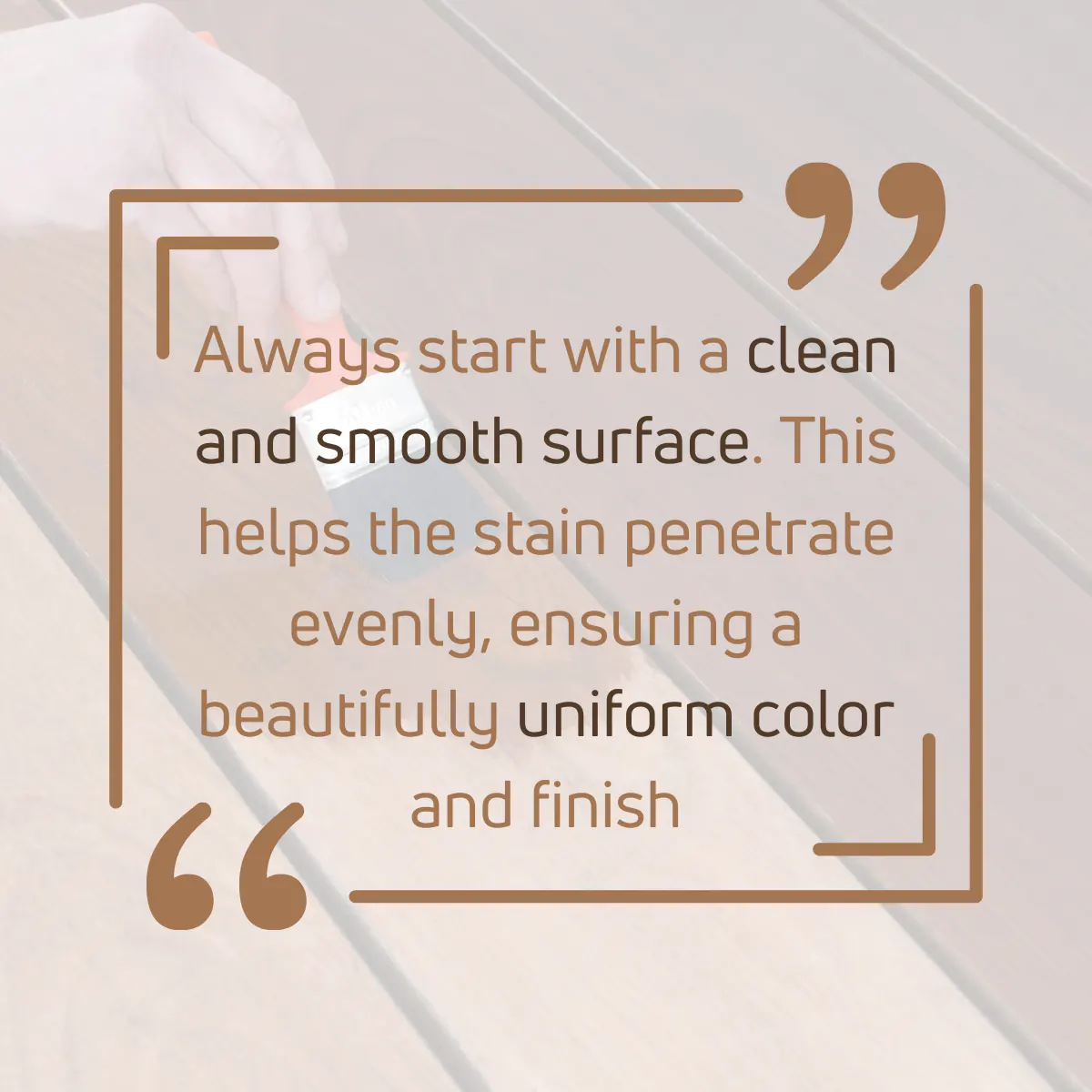
Remember the Pre-Stain Conditioner
No matter what stain you choose, a pre-stain wood conditioner is a must for Douglas Fir.
Pre-stain wood conditioner helps to prepare the wood for the staining process, ensuring that the stain is evenly absorbed, which significantly reduces blotchiness.
Testing is Essential
As we’ve mentioned before, always test your chosen stain on a scrap piece of Douglas Fir before you start on your actual project.
Each piece of wood can take stains differently due to variations in grain patterns, density, and color, and what works best for one might not be ideal for another.
Testing allows you to get a preview of the final look and make necessary adjustments to your application technique or stain choice.
As you can see, the best stain for Douglas Fir largely depends on your specific needs and preferences.
However, gel stains are generally considered a top choice due to their easy application and beautiful, even results.
Read more : Fire Pit Dimensions (Measurements & Size Guide)
Regardless of your choice, don’t forget the crucial role of a pre-stain conditioner and always test before diving into the staining process.

Best Stain Colors for Douglas Fir
Choosing a stain color for your Douglas Fir project can be a lot like picking out the right pair of shoes to match your outfit – it needs to complement and enhance, not detract or clash.
So, let’s journey together through the vast color palette of stains that suit the Douglas Fir best.
Embracing the Natural Tones
Before we dive into the color options, let’s remember that Douglas Fir is naturally a beautiful, warm, orangey-brown hue.
Because of its natural beauty, many woodworkers and homeowners choose to keep it simple and emphasize these natural tones.
If you’re in this camp, consider opting for a clear or natural finish. You’d be amazed at how a simple clear finish can bring out the wood’s inherent charm.
Rich, Dark Stains
For a bold, dramatic look, consider going with a dark stain like mahogany or dark walnut.
These deep, rich colors provide a stark contrast to the light natural color of Douglas Fir.
They have the added advantage of hiding any imperfections or stains on the wood, making them a good choice for older pieces or pieces with visible damage.
Warm, Mid-tone Stains
If you want to strike a balance between the light natural tones of Douglas Fir and the dramatic impact of dark stains, warm, mid-tone stains are a fantastic choice.
Colors like chestnut or golden oak maintain the warmth of Douglas Fir while adding a bit more depth and complexity to its appearance.
They beautifully enhance the natural grain patterns without overpowering them.
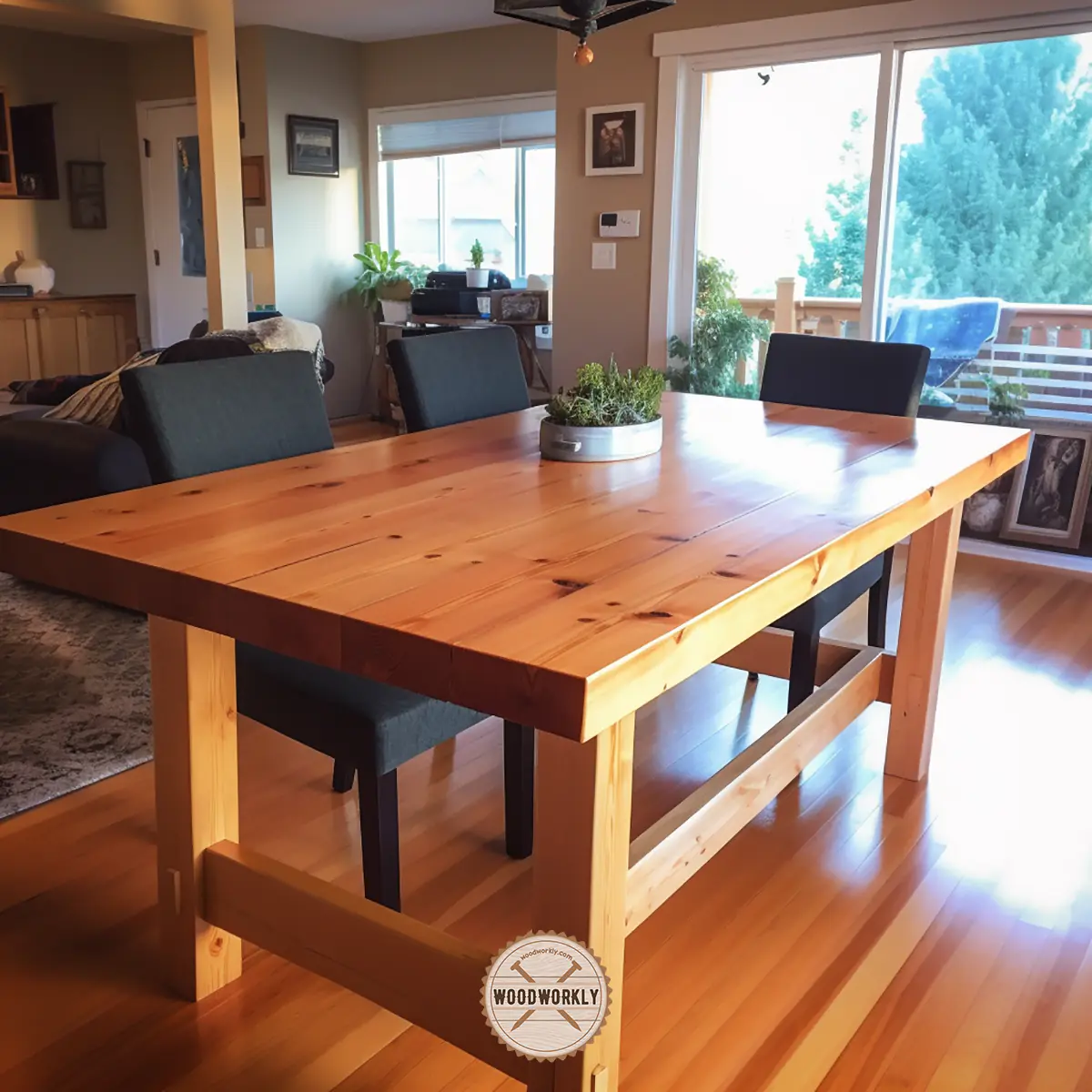
Bright and Light Stains
If your aesthetic leans more towards the light and airy, don’t worry, there are stain options for you too!
Lighter stains like honey, classic gray, or pickling white can give your Douglas Fir a refreshing, modern touch.
However, bear in mind that lighter stains might not hide imperfections as well as their darker counterparts.
Custom Colors: A Unique Option
For those of you who want a truly unique piece, consider custom-mixed stains.
You can combine colors to create a stain that perfectly fits your specific needs.
Or, consider layered staining where one color is applied, wiped off, and then a second color is layered on top.
This technique can create depth and interest, and it allows for a lot of creativity.
If you need to know the method of mixing stains, Read my comprehensive guide about, How to mix wood stains!
Always Test Your Colors
As I mentioned before, and it bears repeating, always test your chosen stain color on a scrap piece of Douglas Fir first.
Stains can look different on the can than they do on the wood, and testing ensures you’re happy with the color before you commit to staining your entire piece.
Choosing the best stain color for Douglas Fir is a subjective process and depends largely on your personal preferences, the piece’s intended use, and its surroundings.
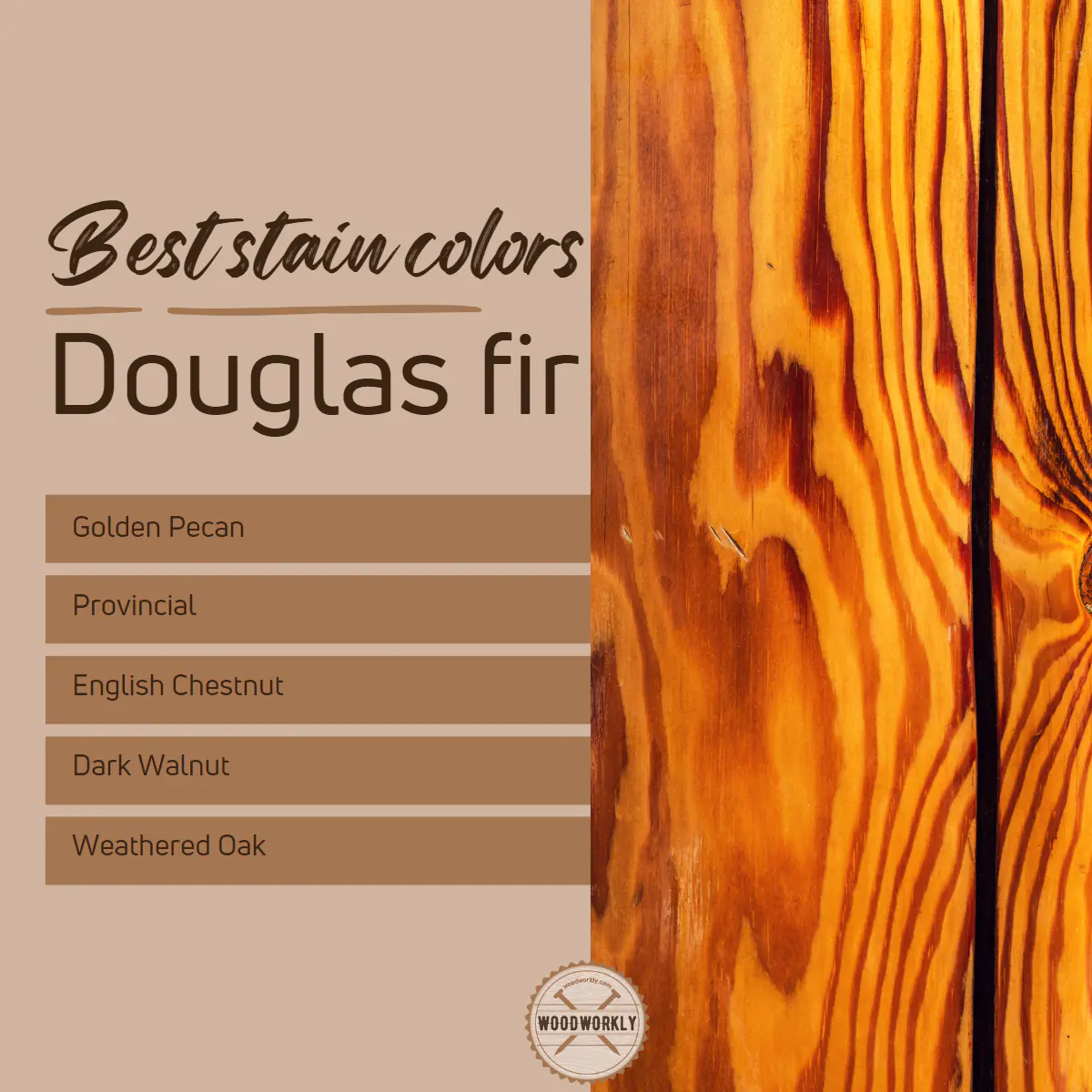
Enough chit chats! Now let’s move into the main topic of staining Douglas fir.
First of all, let’s look at the supplies you’ll need to collect.
Supplies You Will Need for Staining Douglas Fir
- Stain product
- Wood conditioner
- Polyurethane, varnish, or lacquer
- Sandpapers (100 grit, 150 grit, 220 grit)
- Gloves
- Rags
- Paintbrush or bristle brush
- Lint-free tack cloth
How To Stain Douglas Fir?
Before staining Douglas fir you need to have good preparation and patience. Because staining Douglas fir is not an easy task.
Here’re the requirements you need to have before the staining project.
Tip: If you’re going for an oil stain instead of a gel stain, apply wax paste or linseed oil to protect the wood.
For any other type of stain product, apply lacquer, polyurethane, or varnish topcoats to seal and protect the wood.
Here are the steps you need to follow when staining Douglas fir,
- Surface preparation.
- Apply wood conditioner.
- Apply the stain.
- Wipe off excess stains.
- Apply additional coats of stain.
- Let the wood dry completely.
- Seal the wood.
So, let’s discuss each of the above steps in detail you should follow to apply stain on Douglas fir perfectly.
1. Surface Preparation
Because of being a softwood, Douglas fir doesn’t need deep sanding for surface preparation.
But sanding is essential to accept the stain by gaining a nice and smooth surface.
Start with a lower grit sandpaper (like 100 or 150) and then move up to a higher grit (like 220) to get that smooth finish. Remember, always sand with the grain, not against it.
Sanding helps you to remove dust, debris, and surface inconsistencies.
When you’re sanding, make sure to apply even pressure throughout the wood.
Otherwise, the surface will not gain uniform smoothness and cause surface blotchiness once the stain is applied.
A sanding block is recommended to do the sanding with even pressure.
Sanding along the direction of the wood grain helps the wood to accept the stain so well and avoid making any scratches or unsightly marks on the wood.
When you’re sanding the wood pores will open and make them available to accept the stain.
But make sure not to use high grit sandpapers, because they’ll close the wood pores and make them difficult to accept the wood stain
Once you’re done with sanding, clean the whole wood using a rag or clean cloth to eliminate sawdust. Because if you apply stain without removing sawdust, stain bubbles may occur.
The remaining dust and debris can be eliminated by using a sponge or clean cloth.
Cleaning and sanding are the most important part of any woodworking project.
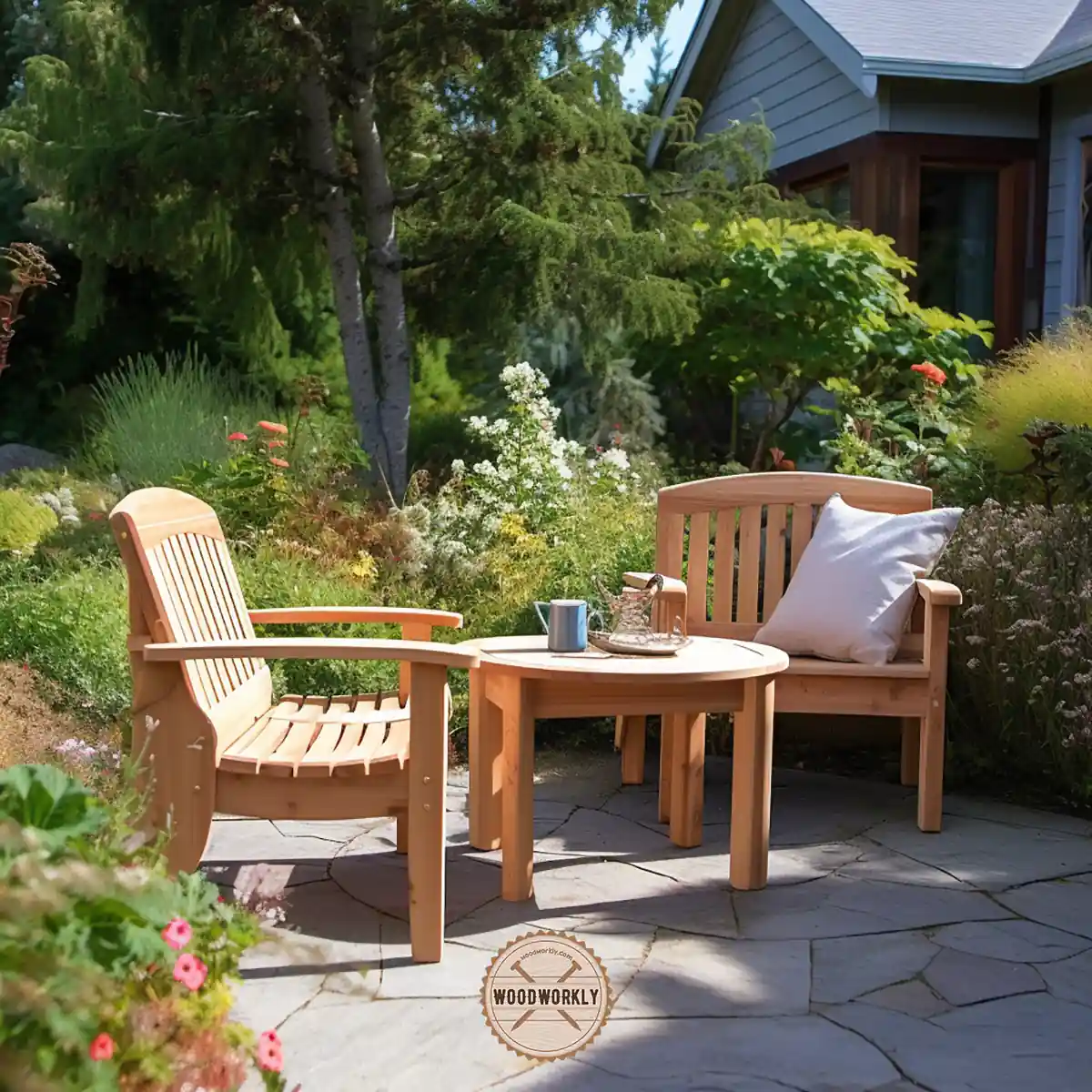
2. Apply Wood Conditioner
Douglas fir is considered a difficult wood to stain because of its uneven texture.
But by applying wood conditioner prior to wood stain, you’ll be able to apply the wood stain evenly throughout the wood surface.
By applying a pre-stain wood conditioner before staining, it will help the wood to take stain evenly without getting blotches and streaks while applying stain.
For a woodworker, my advice is using a wood conditioner before staining is a must with wood like Douglas fir.
Because wood conditioner will help to avoid making most of the wood staining mistakes.
Minwax pre-stain wood conditioner is great for this task which I personally recommend.
But always make sure to take both stain products and wood conditioner products from the same manufacturer to avoid any incompatibilities.
Two coats of wood conditioner are recommended because, as soon as you apply the first coat of wood conditioner, it will absorb as you rub it.
The second coat will be set on top of the wooden surface and make the wood ready to accept the stain.
Read more : Is Using a Hidden Spy Camera Illegal? A State-by-State Guide
Apply wood conditioner evenly through the whole surface and is set for another 15 minutes.
After that remove the excess wood conditioner using a clean cloth and apply the second coat and let it dry for another 15 – 30 minutes.
3. Apply Wood Stain
Once the second coat of wood conditioner is dried completely, you can start applying wood stain to the Douglas fir.
Applying the stain is where your creativity really starts to shine. Using a brush or a clean cloth, apply the stain in the direction of the wood grain.
For a darker finish, leave the stain on for a longer period of time before wiping it off; for a lighter finish, wipe it off sooner.
Make sure to apply thin coats of gel stain to avoid drying issues. Because gel stain has a thick consistency and thick coats of stain can lead to a tacky surface.
Apply stain along the direction of the wood grain for better acceptance and make sure to apply all over the wood with uniform pressure without missing any spot.
Make sure to focus on how much pressure you should apply to the paintbrush. Because the pressure is high the resulting color is deeper.
if you’re using gel stain, one coat of gel stain is well enough for the job. But if you’re using any other type of wood stain, at least two coats of stain are recommended.
Make sure to let the first coat of stain dry completely before applying another coat.
Because proper drying helps to avoid many wood stain mistakes.
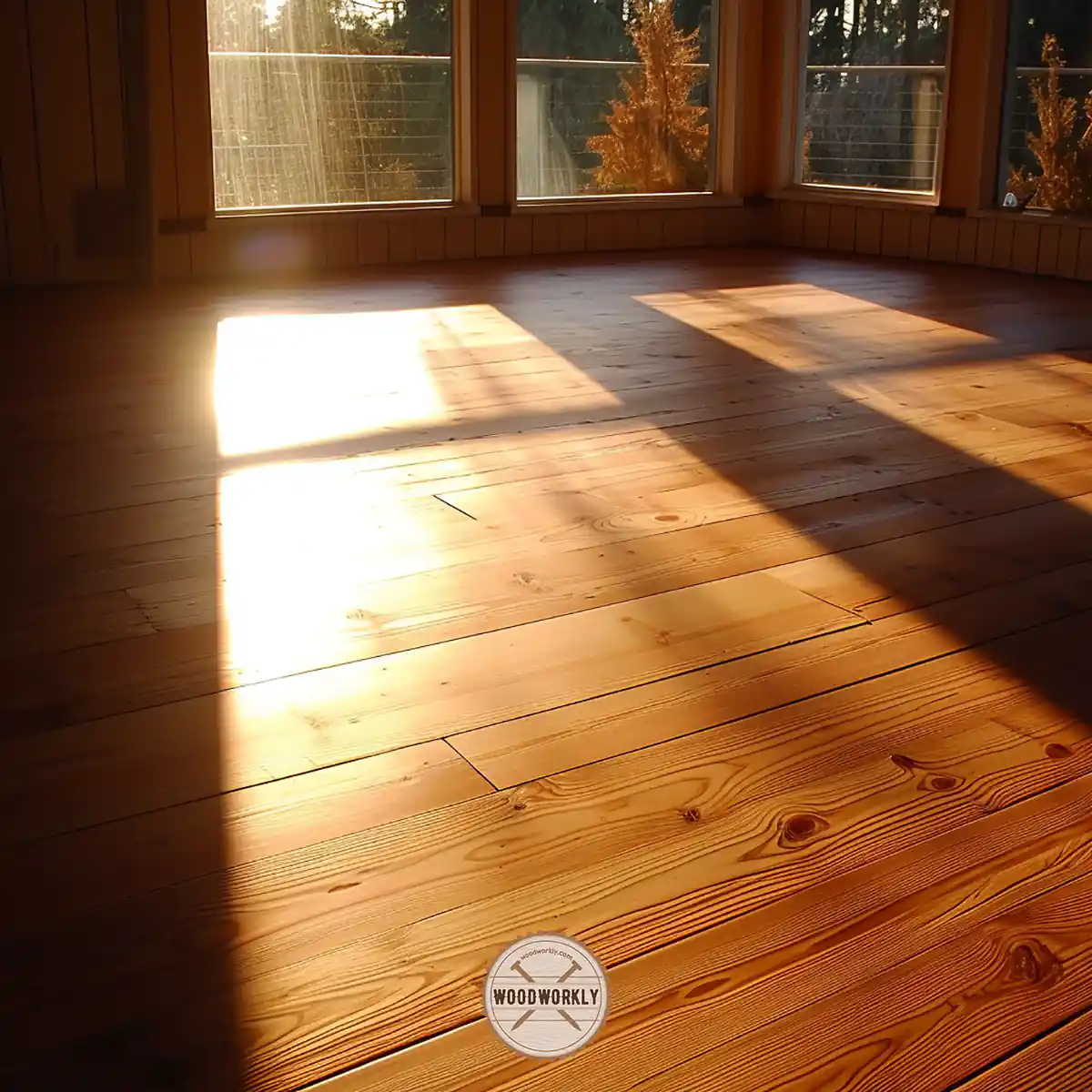
4. Wipe Off Excess Stain
After you’ve let the stain sit for the recommended amount of time (always refer to the can for specific instructions), you’ll need to wipe off any excess.
Using a clean cloth, gently wipe the wood, again in the direction of the grain. This will remove any stain that the wood didn’t absorb.
5. Apply Additional Coats of Stain
For a deeper color and enhanced durability, consider applying a second coat of stain after the first one has dried.
Remember to wipe off any excess stains just like you did after the first coat.
6. Let the Wood Dry Completely
After the application of each coat of wood stain, let the wood dry for nearly 24 hours before applying another coat of stain.
If you apply another coat of stain even before the previous coat dried, that can lead to a serious problem and your whole project can be ruined and will have to start over from the beginning.
So, drying is so important when staining.
Applying thin coats of stain will reduce the drying time and improve the process efficiency.
7. Seal the Wood
The final step in your staining project is to seal the wood. This is like adding a protective layer to your beautiful art piece.
You can choose from a variety of finishes, such as polyurethane, varnish, or lacquer.
Use a clean brush to apply the sealer, following the direction of the grain.
Congrats folks! Now you know the staining process of Douglas fir perfectly without missing any step.
Now I’m going to share with you tips and tricks that are useful when staining Douglas fir that I’ve learned with experience and already practiced for years with no issues.
They will make your staining process much more effective.

Tips For Staining Douglas Fir
Staining Douglas Fir can seem like a bit of a challenge but don’t worry, I’ve got you covered with some tips and tricks that will help you master this task in no time.
So put on your DIY hat and let’s get to it!
Choose the Right Stain
Choosing the right stain isn’t just about the color. While color is important, you should also pay attention to the type of stain.
Oil-based stains tend to penetrate deeper and provide a more durable finish. They’re a good choice for outdoor furniture or other pieces that need to withstand the elements.
Prep Work is Key
Never underestimate the power of prep work. Cleaning and sanding the wood thoroughly ensures the stain adheres properly and gives a smooth, professional finish.
So, roll up your sleeves and put some elbow grease into it. Trust me, you’ll thank yourself later when you see the results.
Test with Scrap Wood
Testing the stain on a scrap piece of Douglas Fir or an inconspicuous spot is a step that is often overlooked, but it’s oh-so-important.
This helps you avoid any unpleasant surprises and ensures the final result will be just what you envisioned.
It’s the equivalent of trying a new recipe with a small batch before making it for a big dinner party.
Don’t Rush the Process
You’ve probably heard this a thousand times, but it’s especially true when staining Douglas Fir.
Letting the stain sit on the wood for the right amount of time before wiping it off can be the difference between a patchy finish and a beautiful, even color.
And remember, always let the stain dry fully before applying a second coat or finish.
Safety First
Always remember to wear gloves and work in a well-ventilated area when staining.
While we’re all for DIY projects, it’s important to keep safety in mind. Stains can be messy and, in some cases, toxic.
Safety glasses aren’t a bad idea either if you’re particularly accident-prone like me.
Seal the Wood
After staining, don’t forget to seal the wood. This will protect the stain and your beautiful Douglas Fir from wear and tear.
It’s like putting a protective shield on your smartphone – it’s an extra step, but it prolongs the life and look of your project.

Does Douglas Fir Stain Like Pine?
Pine is so hard to stain, not like Douglas fir. Pine has uneven density and wood stain hardly penetrates through the wood.
Therefore, most people tend to paint pine wood rather than apply wood stain.
But Douglas fir is comparatively easy to stain and wood stain will absorb so easily due to the porous structure of Douglas fir.
That’s it, folks! Hope you were able to learn everything you wanted to know about does Douglas stain well and the whole staining process of Douglas fir from A to Z.
Let’s answer some frequently asked questions as well.
FAQs
Did I cover all you wanted to know about: Does Douglas Fir Stain Well?
In this article we have deeply discussed about does Douglas fir stain well and is Douglas fir good for staining by taking the unique characteristic features of Douglas fir.
Douglas Fir does stain well, but it’s not easy. The uneven texture and variable porous structure of Douglas fir make the wood difficult to stain. The red and orange hues of Douglas fir can pop through the stain, and you need to have good preparation and patience before staining.
Gel stain is considered the best wood stain for Douglas fir and only one coat of gel stain is enough to make the project succeed.
Furthermore, we have discussed how to stain Douglas fir without making any wood staining mistakes and answered some frequently asked questions as well.
Hope you have gained good knowledge about does Douglas fir stain well and how to do that.
So, let’s begin your next woodworking project with Douglas fir. Have fun in wood finishing!
Related Posts
- Does Stains Lighten As It Dries? Find Out Now!
Source: https://gardencourte.com
Categories: Outdoor


